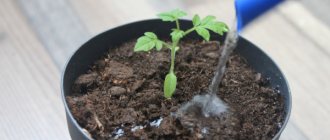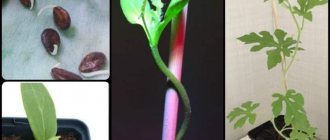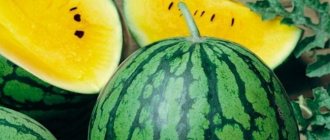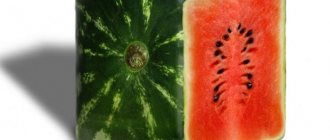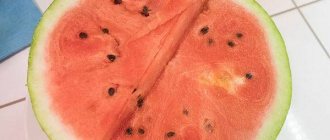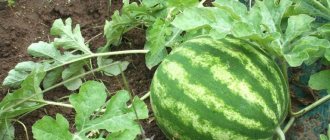What kind of watermelons are these?
Melons are propagated using seeds that ripen in the pulp of the fruit. Watermelons that do not contain them require special growing conditions. They have all the advantages of the usual varieties - sweetness, aroma, high content of vitamins, minerals and fructose.
History of origin and distribution
Japanese breeders were the first to grow seedless watermelons. The successful experience of Kyoto University in changing the chromosome set of traditional watermelons led to the emergence of the first unique varieties in the 40-50s of the 20th century.
Following the land of the rising sun, the technology was mastered by breeders from the USA, Bulgaria, Holland and other countries. Only in the 21st century did watermelons without seeds appear in our country and immediately gained popularity among consumers.
Now the volumes of cultivation of such varieties are comparable to traditional ones. Buyers prefer to purchase seedless watermelons because they contain virtually no waste and the aesthetics of consumption are much higher than varieties with seeds.
Important! Despite the concerns of some adherents of proper nutrition, such fruits are not genetically modified, since the genes of other representatives of flora or fauna were not involved in their creation.
Peculiarities
The traditional watermelon is a diploid because it has two sets of chromosomes. Seedless varieties are triploids, which have acquired new properties thanks to the action of colchicine. To grow such watermelons, the manufacturer cultivates three varieties of melons. This is necessary for pollination of those flowers that will produce fruits with the desired properties.
Advantages and disadvantages
The main advantages of seedless watermelons are the increased sugar content, ease of consumption, and high yield.
Minuses:
- high requirements for temperature and humidity: when the temperature drops to +3...+5°C, plants die, as well as with a lack of moisture;
- seedless varieties are more susceptible to pest attacks and melon diseases than traditional ones;
- the inability to grow such watermelons without the use of pollinating varieties;
- When technical ripeness is reached, harvesting should be carried out immediately, otherwise there is a risk of losing the harvest.
Growing fruits without seeds requires scrupulous adherence to technology and careful care.
Harvest
Unlike fruits with seeds, triploid watermelons collected in advance do not ripen. Therefore, they should be collected only when they reach consumer maturity. The accuracy of assessing the degree of fetal maturity comes with experience. To do this, you can use such signs as the color of the fruit, yellowing of the peel at the point of contact with the soil, the severity of the waxy coating, the color and condition of the tendril, and others.
As a rule, compared to traditional varieties, seedless watermelons produce a higher yield per unit area and tolerate storage and transportation better. You can increase the shelf life and improve the quality of fruits by refrigerating them or harvesting them at the coolest time of day.
When using the above recommendations, local conditions should be taken into account. Knowing effective techniques and becoming familiar with the most successful elements of technology, you can develop an individual cultivation plan that guarantees a high yield.
Alexander Nikitin,
Ph.D. s-x. sciences
Seedless watermelon hybrids
To date, breeders have already bred several dozen hybrids, some of which have become widespread in Russia.
Ecstasy F1
Hybrid has an average ripening period - 75-80 days from germination to technical ripeness. The fruits are perfectly round and weigh from 1.5 to 2.5 kg. The peel is dark green, with light stripes, shiny. The flesh is crispy, dense, intense red in color. Productivity – 90-95%. Unpretentious in care, demanding on soils and humidity levels. Tolerates transportation and storage well.
Imbar F1
The early hybrid reaches ripeness 60-65 days after emergence. The peel is dark green, with black stripes. The pulp is juicy, yellow, sweet. Fruit weight is from 4 to 6 kg. A productive, heat-loving hybrid that requires care.
King of Hearts F1
Mid-early hybrid, with a ripening period of 75-85 days. The fruit is oblong, the skin is thin. The flesh is crispy, very sweet, bright red. The fruits reach a weight of 7-9 kg. Requires the presence of a pollinator variety.
Regus F1
Early maturing hybrid for open ground and greenhouses. For every two Regus F1 seedlings, one pollinator plant is planted. The fruit is round in shape, with a light green peel covered with thin dark stripes. The pulp is pinkish-red, sweet. The weight of ripe watermelons is from 6 to 8 kg. Resistant to various diseases of melons, tolerates transportation and storage well.
Boston F1
Early highly productive hybrid. The weight of the fruit reaches 7-8 kg. The peel is thin, light green, with dark spiny stripes. The fruit is round in shape, the flesh is reddish-pink, sweet, juicy.
Boston F1 is cultivated in a wide range of climatic zones. Storage-resistant and transportable.
Crimson Suite F1
One of the most popular early ripening hybrids. The fruits are round in shape and reach a weight of 8-9 kg. The peel is shiny, thin, light green with dark stripes. Outwardly it resembles an Astrakhan watermelon. The pulp is raspberry-red, with a characteristic aroma, sweet.
Sagas F1
Mid-season hybrid with high yields. The fruits are oval, weighing 9-11 kg. The peel is light green with dark stripes. The pulp is red, with increased sugar content, aromatic. In cooking, they are used fresh, for fermentation and making juices, smoothies, and desserts.
Yellow Buttercup F1
Mid-early hybrid with a ripening period of 75-85 days. The fruits are round, large, with an average weight of 8-10 kg. The peel is shiny, light green with dark stripes. The pulp is bright yellow, juicy, sweet and aromatic. Designed for the southern regions of the Russian Federation.
The nuances of growing seedless watermelons
Seedless hybrids require special attention during cultivation. Most are susceptible to diseases characteristic of melons . They are grown in open ground, as a rule, in the south of Russia; in other regions, mainly in film greenhouses and hotbeds.
The germination rate of the seeds of such watermelons is low, so the choice of planting material should be approached responsibly and purchased only from trusted companies. It is better to buy seeds with a reserve if the gardener plans to get a harvest not only for himself, but also for sale.
Favorable soil temperature for germination is +18...+20°C, therefore, given the short summer in most regions of Russia, the seedling growing method is preferable.
The sterility of seedless hybrids requires the presence of pollinating varieties. For every two seedless plants, one pollinator seedling is planted. There are no requirements for a specific variety, the main thing is that it must have seeds.
Planting with seedlings and without seedlings
Most often, seedless hybrids are grown through seedlings. They are sown in open ground only in the south when the soil has warmed to optimal temperatures.
Several methods are used for growing seedlings:
- on damp cotton pads;
- on paper towels or toilet paper;
- in individual trays or containers with soil for melons.
It is strictly forbidden to soak the seeds of hybrids. In this case they will rot.
When sowing in trays, the soil is disinfected with a weak solution of potassium permanganate and well moistened. The seeds are immersed in the ground with the sharp end down, deepening no more than 1 cm. Containers with seedlings are placed on window sills or shelves with lighting. For seed germination, an air temperature of at least +25°C is required.
Shoots will appear in 4-6 days. Water the watermelons moderately, avoiding drying out or waterlogging the soil. After 4-5 weeks, the plants are planted in a greenhouse or open ground.
With the seedless method, seeds are sown in prepared soil. To do this, the area for planting is dug up to the depth of a spade bayonet, harrowed and well watered. The recommended sowing method is in a checkerboard pattern. There should be at least 1.5 square meters per plant. m of food area.
Care
Further cultivation of watermelons consists of loosening the soil at least once a week, watering and fertilizing. Drip irrigation or sprinkling from a hose is considered optimal for seedless watermelons.
The leaves of mature plants are large enough to protect the fruit from sunburn and retain moisture in the soil. For strongly climbing watermelons, trellises are prepared, the rest are grown into sprouts.
Important! Almost all hybrids produce many lashes, so most of the side shoots are removed, otherwise the plant will not be able to provide adequate nutrition for all the ovaries that form.
Hybrids are fertilized 2-3 times during the growing season. For feeding, complex mixtures are used, but without nitrogen content, since its high content leads to cracking of the fruit.
Weeding is necessary in the first 3-4 weeks; subsequently, the abundant foliage of watermelons does not allow foreign plants to develop.
Common problems
Hybrids are susceptible to diseases of melon crops and pests, so it is necessary to fight for the health of plants from the first days of planting in the ground. Crop rotation rules are used to protect against the most common diseases. Hybrid watermelons grow well after potatoes, tomatoes, peppers, eggplants and other nightshades and legumes.
The most common diseases:
- powdery mildew;
- rot;
- anthracnose;
- fusairous wilt;
- mosaic;
- spotting.
To prevent diseases, dead parts of plants are promptly removed, the soil is deeply loosened, the tower is mulched, and weeds are removed.
It is impossible to fight fusarium - the disease affects watermelons starting from the roots. Therefore, when signs of disease appear, the plants are weeded out and burned. Anthracnose recedes after spraying the plants three times with a one percent solution of Bordeaux mixture. Treatment is carried out every 7-10 days.
When root rot appears, watermelons are watered with a weak solution of potassium permanganate to disinfect the soil. After 2-3 days, the plants are treated with preparations containing metalaxyl.
Bacterial spotting cannot be treated; the plants are destroyed and the soil is disinfected with a solution of potassium permanganate. Powdery mildew recedes after treating watermelons with Bayleton, Topaz or Planriz. To prevent white and gray rot, watermelons are sprayed with fungicides three times at weekly intervals, for example, Acrobat MC or Topaz.
Watermelon pests:
- wireworm;
- spider mite;
- aphid;
- tobacco thrips;
- cucumber beetle.
To prevent the transfer of pests from plants that are familiar to them, watermelons are not grown next to carriers, for example, potatoes, cucumbers, and tomatoes. For treatment against insects, insecticides are used: against ticks “BI-58”, against thrips and aphids - “Fitoverm”. Spraying is carried out on young plants and after flowering.
Preparing and planting seeds
Watermelon seeds are planted at the beginning of summer, sometimes in May, when the weather is warm. Experienced melon growers who know well how to grow watermelons understand that a lot depends on the quality of the seeds. Take seed material zoned for early ripening in your area. Before planting, specially treat:
- Warm up for 10 days (create a temperature for dry seeds of about 55 degrees - calcination in the sun). You can simply warm up the seeds near the radiator in February.
- Soak the seeds in water for half an hour and remove any that float.
- After this, pour hot water at 50-60 degrees into the bowl with the seeds and leave until it cools. Drain this water and pour in new water for biting.
- 3 days before sowing, soak the ash in water in a ratio of 1:2, respectively, leave for half a day, stirring.
- Dip the seeds in a dark solution of potassium permanganate, rinse, and soak overnight in the prepared ash solution.
When sowing, focus on a soil temperature of 15 degrees above zero. The soil should be loose and fertile. Sow 10 seeds per linear meter to a depth of 6-8 cm (not all will sprout). If low temperatures prevent you from sowing a crop in a timely manner, you must first germinate the seeds in a peat pot. During this time the earth will warm up. When the temperature changes, a square watermelon is grown in a greenhouse.
Propagation of seedless watermelons
It is impossible to do this at home. Breeders take ordinary watermelons with two sets of chromosomes (diploids) and treat them with a mutagen. In our case it is colchicine. The result is a hybrid with four sets of chromosomes (tetraploid). A diploid and a tetraploid are then crossed to produce a triploid, which has three sets of chromosomes and is therefore sterile and seedless.
Advantages and disadvantages of a square shape
What qualities of fruits attract consumers so much? Among the advantages are the following:
- Convenience of a square shape, from a pragmatic point of view, for transportation and storage. It is no secret that a round berry will shift and move during transportation and is difficult to set still. Ripe watermelons burst easily, even if they are rearranged too much. This product is difficult to put into place, it rolls around and may fall and break. Crop losses can be quite significant. The square option certainly solves this problem.
- When using the product directly as food, it is also difficult to place it on the table, on a plate, or put it in the refrigerator. There are no difficulties with a square fruit.
- The laws of the market stimulate the emergence of new forms of goods that are attractive, original, exotic, and capable of surprising and delighting. A square watermelon, without a doubt, surprises with its non-standard shape. As a gift or decorative element, it will capture the imagination of guests.
For your information, this is an ordinary watermelon, its excellent taste and composition remain unchanged. Among the disadvantages of square fruits, as the Japanese testify, is that they ripen unevenly. Therefore, it is better to use them as an attribute, decoration at various celebrations.
Reviews
There are many gardeners who like to experiment with new watermelon hybrids. Our readers shared their observations useful for summer residents.
Valentina, Rostov-on-Don : “I grow watermelons without seeds - this is the main direction of my peasant farm. There are many buyers, the goods do not linger. On my farm, the entire area occupied by watermelons is equipped with a drip irrigation system, so the cost is low, and I can easily compete with producers of traditional stone fruit varieties.”
Igor Nikolaevich, Mozhaisk: “For the third year in a row I will grow Crimson Sweet. I like this variety for its unpretentiousness, disease resistance and high yield. The whole family and our friends are delighted - the watermelons are delicious, sweet, seedless. I grow it in a greenhouse, I get about 100-120 fruits per season and we eat them until the New Year.”
Svetlana, Astrakhan: “Last year I tried to grow it for the first time - only three out of 10 seeds sprouted. But I was pleased with the harvest - I collected 32 watermelons. Last time I grew seedlings, this time I plan to go straight into the ground, they say that hybrids in our region germinate better this way.”
Pollination
For normal seedless formation, several strips of ordinary diploid watermelon varieties are planted on the field for crossing. It is desirable that the pollinating watermelon differ in appearance from the seedless one. This will help separate the varieties by type when harvesting.
The optimal ratio of seedless watermelons to pollinator is 3:1 or 2:1, depending on the hybrid and growing conditions. With direct sowing, the pollinator is sown 7-14 days later than the triploid. With the seedling method, sowing is done 14 days later after sowing the pollinator.
Also, for successful pollination of watermelon, it is recommended to have bees on the field - 5 hives per hectare. They are placed at the beginning of flowering with a distance between hives of 250 meters.
Please note that seedless watermelon is more difficult to harvest due to the fact that it may be the same in appearance as the pollinating watermelon.
Also, excess formed watermelons affect the size of the berry, so it must be removed in time.



